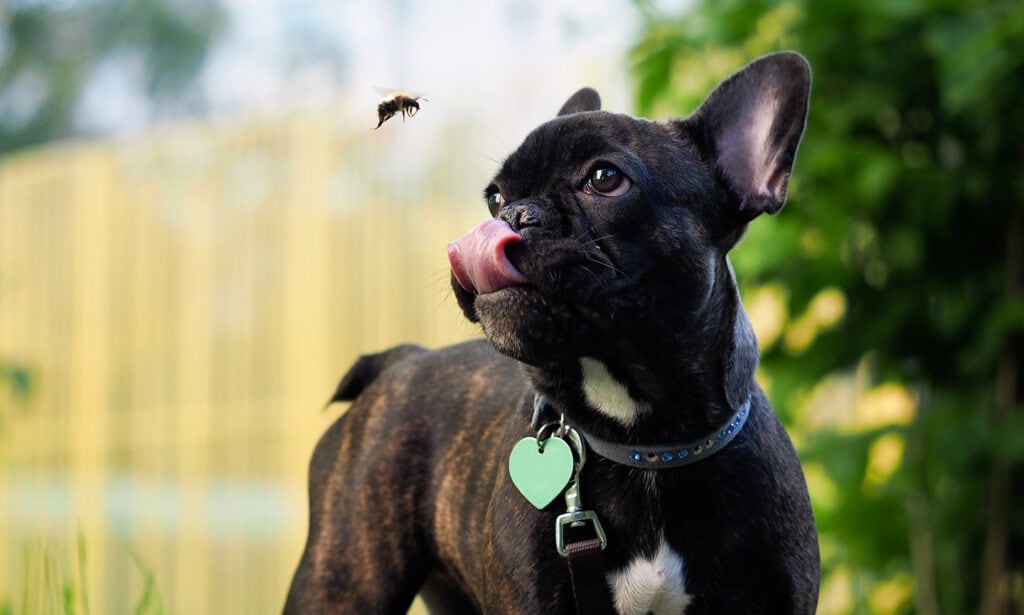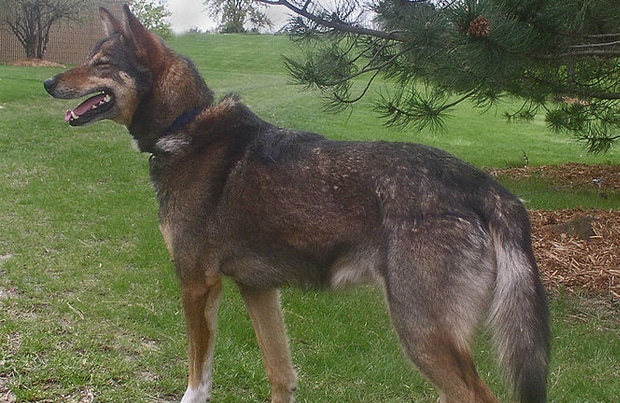You’re strolling with your pup on a blissful spring afternoon when, suddenly, your furry companion jerks and snaps at their side in distress. You look around and see the yellow-and-black perpetrator buzzing off. Your dog was stung by a bee.
Many dogs will only experience temporary discomfort after a bee sting. But, others might have more serious reactions, including severe swelling or even a life-threatening allergic reaction called anaphylaxis.
We spoke to vet experts for advice about what to do if your dog has an unfortunate run-in with one of these buzzing insects.
In This Guide:
Bee or Wasp Sting Symptoms in Dogs
Most dogs will only have a mild reaction to bee or wasp stings, displaying symptoms including:
- Localized swelling
- Red, warm skin around the sting site
- Itchy skin around the affected area
- Drooling (if your dog was stung in their mouth)
- Holding up a paw or limping (if they were stung on a paw)
- Biting or pawing at the affected area
- Whining
What To Do if Your Dog Has Been Stung by a Bee or Wasp
Arming yourself with first-aid knowledge about how to handle dog bee stings can give you the confidence to offer top-notch care if a bee or wasp ever decides to show your dog who’s boss.
Step 1: Stay Calm
“If your dog has been stung by a bee or wasp, the first step is to remain calm and assess the situation,” says Ashly Smith, DVM, regional medical director for Small Door Veterinary’s Washington, D.C., practices.
Keeping your cool can help you get an accurate picture of the severity and also help prevent your pup from becoming more anxious or agitated. Calmly approach your dog and carefully examine the site of the sting.
Step 2: Remove the Stinger
If the stinger is embedded in your dog’s skin, gently remove it using a pair of tweezers or by scraping it out with a credit card’s edge, says Dr. Smith. Avoid using your fingers, as this may result in accidentally pushing the stinger further into the dog’s skin or releasing more venom, she adds. The longer the stinger stays in the dog, the more venom is injected.
Step 3: Apply a Cold Compress
Next, apply an ice pack (wrapped in a towel) or a cold compress to the sting site to reduce swelling and pain, says Dr. Smith. Hold the compress against the affected area for 10–15 minutes. Avoid applying ice directly to your dog’s skin, as this can damage their skin.
Step 4: Monitor for Signs of an Allergic Reaction
From the moment your dog is stung (and for about 24 hours after), watch for signs of a moderate or severe allergic reaction. Allergic reactions from bee stings usually happen within 20 minutes of being stung, but in rare cases, it can be delayed for hours. If you notice any concerning symptoms, seek medical help immediately. (More on this shortly.)
Step 5: Call Your Vet
“If your dog has been stung by a bee, the best thing to do is call your veterinarian to see what you should do, as every situation is different,” says Fleur Jones, DVM, an emergency veterinarian at Veterinary Emergency Group in Clearwater, Florida. For example, you can ask your vet if you should give your dog an antihistamine, like diphenhydramine (Benadryl®)
Even if the case appears mild, getting your vet’s opinion can provide peace of mind and safeguard your pup’s health.
Step 6: Prevent Licking and Scratching
If your dog is scratching the affected area, use an Elizabethan collar or recovery cone, like All Four Paws Comfy Cone, to prevent further trauma to the area, which can cause a secondary infection.
Can Dogs Be Allergic to Bee Stings?
Like humans, dogs can be allergic to bee venom, in which case they’ll experience a more severe immune system reaction than normal. The symptoms experienced vary depending on how allergic the dog is.
Signs of Anaphylaxis or a Severe Allergic Reaction
If a dog is severely allergic to bee stings, they might experience a serious and potentially life-threatening allergic reaction called anaphylaxis. Dogs are also more prone to have a severe allergic reaction if they have been stung in the past or if they were just stung multiple times at once. While anaphylactic reactions to insect stings are rare in dogs, they can occur within minutes of your dog being stung by a bee, and can be fatal if not treated promptly, says Dr. Jones.
Signs of anaphylaxis in dogs may include:
- Difficulty breathing (rapid breathing, wheezing, panting or gasping for air)
- Swelling of the face or throat, or swelling on parts of the body other than where they were stung
- Pale or blue gums
- Hives on any part of the body
- Drooling
- Vomiting
- Diarrhea
- Weakness, lethargy
- Agitation or anxiety
- Seizures/convulsions
- Collapse
If you suspect your dog is experiencing anaphylaxis, head to a vet clinic stat. Anaphylaxis is an emergency situation that requires prompt treatment with medications to stabilize your dog’s condition.
How To Prevent Bee and Wasp Stings in Dogs
While it’s impossible to completely protect your dog from bee stings, there are steps you can take to reduce the risk:
- Avoid areas with high insect activity: When possible, steer clear of areas known to have high bee or wasp activity, like flower gardens or areas with known beehives.
- Stay alert during outdoor adventures: When enjoying outdoor adventures with your dog, watch for signs of bees or wasps, such as buzzing sounds or visible nests.
- Avoid disturbing nests: If your dog has a history of finding and pawing at nests, consider keeping them on a leash in late spring and early summer when bees are the most active, especially where there are flowering plants.
- Use natural deterrents: Consider using natural insect deterrents, such as citronella candles, mint plants or essential oils with insect-repellent properties to deter bees and wasps from approaching your outdoor space.
- Avoid using sweet-scented products: Floral perfumes, lotions or sweet-smelling dog shampoos may attract bees and wasps.
FAQs About Dog Bee Stings
Q:
Can I use Benadryl® for dog bee stings? What about other antihistamines?
Q:
My puppy was stung by a bee. What do I do?
Q:
What if my dog is stung on the head, mouth or nose?
Q:
My dog got stung on the paw. How do I remove a bee stinger from my dog’s paw?
Q:
What is the best bee sting treatment for dogs?
Q:
My dog ate a bee. How should you handle bee stings in a dog’s mouth?
A:If your dog swallowed a bee or wasp, there’s a risk of an allergic reaction or irritation in the gastrointestinal tract, says Dr. Smith. “The stinger itself can also cause injury if it becomes lodged in the mouth or throat.”
If you suspect your dog has ingested a bee or wasp, contact your veterinarian for guidance.
More dog safety tips:
Share:











